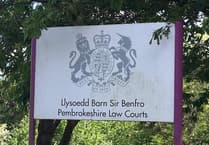With reports of members of the public being hit with hefty fines for breaching dog ban byelaws on some of the county’s beaches in recent weeks, many are asking if the restrictions are somewhat draconian for a place that is portrayed as ‘Dog Friendly Pembrokeshire’ to holidaymakers and residents...or are the Council justified in preventing areas such as Tenby’s Castle Beach becoming a ‘Crufts’ like show for the summer season.
Anyone planning to take their four-legged friends along to the seaside have been reminded that seasonal dog restrictions are now in place on some Pembrokeshire beaches between May 1 and September 30.
While many beaches welcome dogs all year around, between these dates total dog bans are in place at Tenby’s North beach and Whitesands; while partial dog bans cover Lydstep, Newgale beach and pebble bank, Coppet Hall (voluntary), Saundersfoot beach, Tenby Castle and South Beach, Amroth, Poppit Sands, Broad Haven North and Dale.
The dog bans are subject to enforcement with a maximum penalty of £500 for breaches of the bylaws.

Since the restrictions came into place on May 1 many dog owners have been hit with Fixed Penalty Notices, with WISE enforcement wardens employed by PCC to tackle a range of environmental crimes, now also tasked with patrolling beaches for such breaches.
Saundersfoot County Councillor Chris Williams has been working with holiday accommodation agencies, along with businesses and bars that have access to the main beach to make them aware of the restrictions in force.
“I feel that making people aware of the enforcement is a positive step and enforcement should only be used if people continue to abuse the rules,” he said.
“It has been unfortunate that individuals continue to ignore the ban and this is a very small minority of dog owners who let the majority down.
“Last week I was contacted by a local resident who received a ticket for walking her dog along the shoreline.
“I would clarify with reference to the Council’s plans [information boards] showing the beach restricted areas - unlike a land plan, which has fixed boundaries, the boundaries of a beach can change with the tide. This means that the low shoreline is a movable line, not a fixed area.
“Therefore, when considering the restricted area, it’s important to include the shallow shoreline as well.
“This is a complex issue, and it seems like there might have been some misunderstanding about this,” he added.



